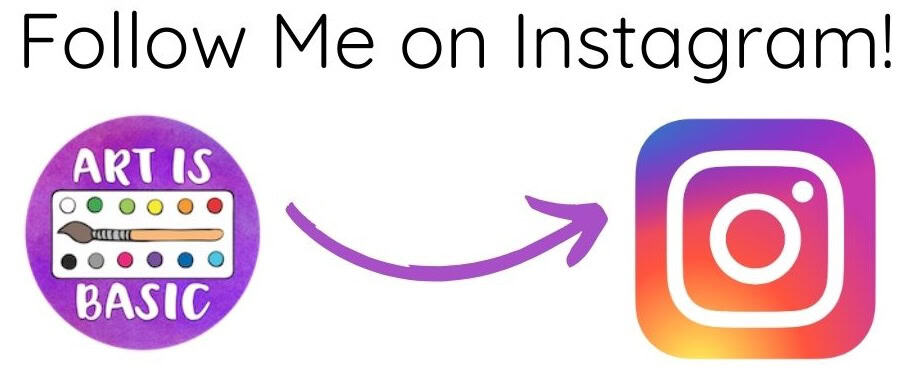

I am always trying to come up with new ideas for my youngest students to experience painting in a successful way, learn about important art concepts and still be able to use their creativity. In this lesson, the goals were the following:
Students will…
- Practice using a paintbrush properly.
- Learn about the qualities of watercolors through instruction and exploration.
- Experiment with watercolor resist.
- Be able to identify common shapes such as circle, diamond, triangle, trapezoid, star, square, oval, rectangle, heart and crescent.
- Practice drawing a variety of shapes. Be introduced to the shapes trapezoid, pentagon, hexagon and octagon.
- Be introduced to the idea of concentric shapes (Concentric describes something, like circles, that have a common center. I explain that you can draw a circle and then repeat circles one inside another.)

Materials:
- 12”x18” piece of white tagboard or other thick paper
- Watercolor paints, brush, cup of water
- Sharpie marker
- Crayons
To begin this lesson, discuss common shapes. Encourage the children to share as many shapes as they can think of and draw them on the board for reference. Students can practice drawing these shapes at their table on a piece of paper or dry erase board. While shapes may seem basic, it may surprise you that a kindergartner might not know what an oval or a rectangle is. A 5-year-old may have never attempted to draw a star before. Reviewing and reinforcing these concepts is beneficial for art, as well as math. Read a book about shapes such as The Snake Shapes Book, by Gene Yates or When a Line Bends, A Shape Begins by Rhonda Gowler Greene.
To prepare for this art lesson, fold one sheet of 12″x 18″ tagboard (or other thick paper) in half horizontally and then unfold. Fold in half vertically and unfold. Finally, fold both of the sides into the center and unfold. When you finish folding, there should be 8 rectangles on your page. Do this for all of the students, so the papers are pre-folded. (Pro-tip: this is a great task for one of your older students who finishes early.)
On the first day, demonstrate how to draw one shape (circle, triangle, square, oval, etc) in each space. We used Sharpie markers.

Then, show students how to color using concentric shapes inside the first. For example, if you drew a circle first, color around the inside edges with a crayon to form another circle. Then, choose a different color crayon and color in another ring. Some of the students will love this and color everything using concentric shapes. Other students will want to color in their shapes solidly or with different patterns. Give them freedom to experiment with how they want to color. Encourage them to color firmly and solidly, filling in all of the white spaces in their shapes. Leave the background blank for now.


On the second day, demonstrate watercolor techniques. This may be their first exposure to watercolor paints, so demonstrate how to dip a brush in the cup of water, get their paints a little wet and brush the paints on the paper.
 You can’t take anything for granted with the youngest students, so demonstrate how to gently use the brush and how to rinse off the brush in between colors. Explain that if they go from color to color without rinsing, they may turn all their colors brown. Demonstrate how to paint a section with one solid color. Then, demonstrate how you could take another color while the paint is still wet and dab it on to the first color to blend them. Keep paper towels nearby and teach the students how to use a paper towel to dab up big puddles of paint.
You can’t take anything for granted with the youngest students, so demonstrate how to gently use the brush and how to rinse off the brush in between colors. Explain that if they go from color to color without rinsing, they may turn all their colors brown. Demonstrate how to paint a section with one solid color. Then, demonstrate how you could take another color while the paint is still wet and dab it on to the first color to blend them. Keep paper towels nearby and teach the students how to use a paper towel to dab up big puddles of paint.



Here are some of the finished artworks!







To extend this unit on shapes, students can work in pairs to create large collaborative shape watercolor paintings. They can use what they have learned to make freestyle layers of shapes and color with crayons and watercolor paints. Or, they can try the watercolor resist technique again using different types of lines instead.

I’d love to hear from you. Leave a comment to say HI!
Discover more from Art is Basic | Elementary Art Ideas
Subscribe to get the latest posts sent to your email.






























what a wonderful lesson packed with objectives, techniques, creativity, and fun !! Inspires me to break out the paint boxes sooner than later.
As a kindergarten teacher I love this idea! What a fun way to teach about shapes!
What beautiful projects you have for little ones! I am so happy I found your blog:)!
I think it’s wonderful how you were able to get some beautiful art from young people. Hopefully they will not forget what they learn and go on to master painting in watercolor.